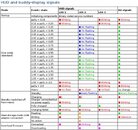ajduplessis
Contributor
More useless information.......
Welcome to ScubaBoard, the world's largest scuba diving community. Registration is not required to read the forums, but we encourage you to join. Joining has its benefits and enables you to participate in the discussions.
Benefits of registering include
... What if you had two independent circuits ... Is it inevitable that you have to manually keep track of everything?
Let me try to summarize some of the points ... do take this with a 3000 lb block of salt ...

With digital systems you only have a very short analog run from the cells to their digital conversion. Millimeters really. In an analog system you have the whole run to the handset/HUD, so now you have long skinny wires with low voltage trying to stay accurate across a long distance while they are very close to each other and subject to interference. With digital you have digital signals being sent, it doesn't remove any difference in the cell quality, but it removes a lot of variables in signal quality so the units are now more reliable, that's just a fact, you'll never get anyone who knows what they're talking about saying that the analog electronics are better than digital because they'd just be wrong. Proof of this? Leon Scamahorn switched the Meg to digital..... Game over folks, anyone still building an analog unit is in the stone age for this.
Imagine an ideal rebreather that comes with a single LED in the HUD. When it is green, you can dive without worry.
When the LED turns red, you must stop whatever else you are doing, close the dive/surface valve manually to prevent water from entering, spit out the mouthpiece, and then begin breathing from your bailout open circuit reg. If you do these steps correctly, you safety is assured.
So, the imaginary ideal rebreather has one indicator, and that thing has two states: green or red.
